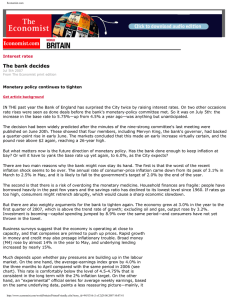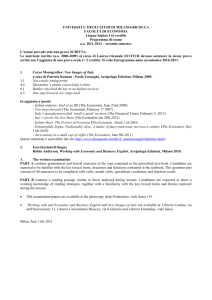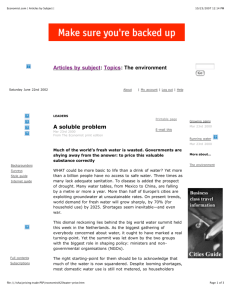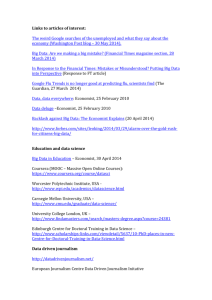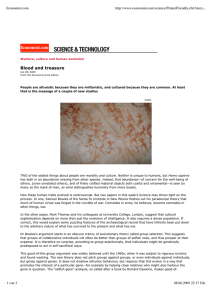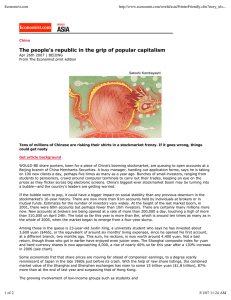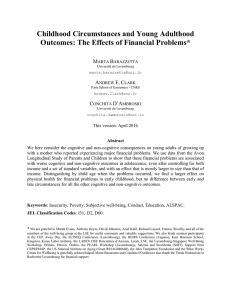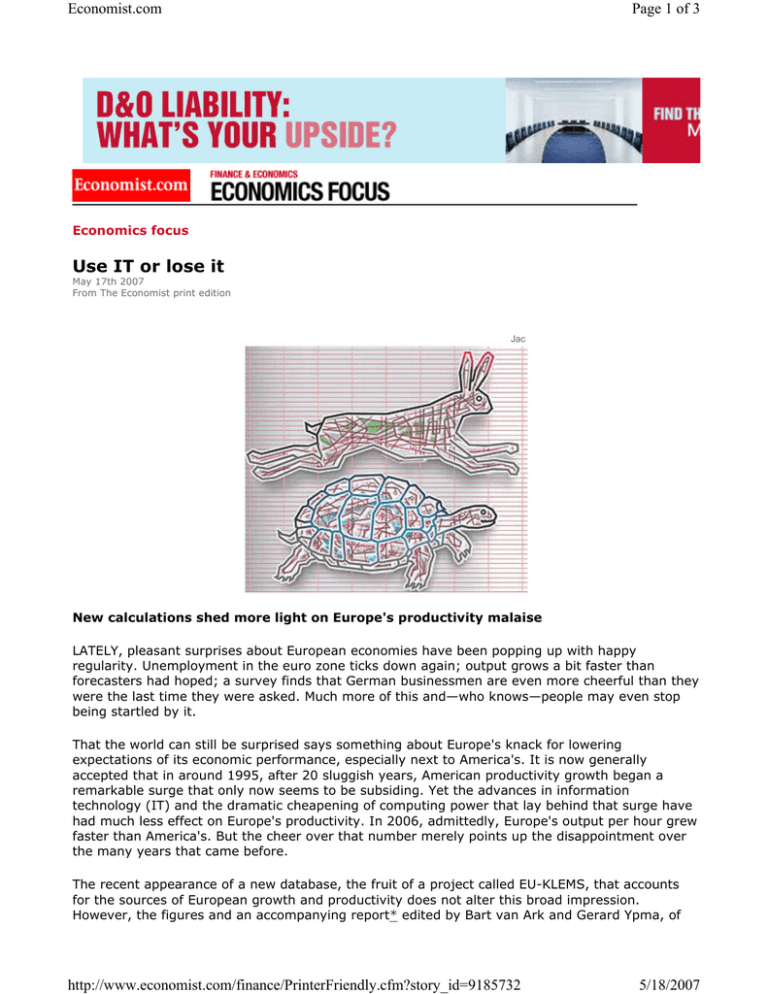
Economist.com
Page 1 of 3
Economics focus
Use IT or lose it
May 17th 2007
From The Economist print edition
Jac
New calculations shed more light on Europe's productivity malaise
LATELY, pleasant surprises about European economies have been popping up with happy
regularity. Unemployment in the euro zone ticks down again; output grows a bit faster than
forecasters had hoped; a survey finds that German businessmen are even more cheerful than they
were the last time they were asked. Much more of this and—who knows—people may even stop
being startled by it.
That the world can still be surprised says something about Europe's knack for lowering
expectations of its economic performance, especially next to America's. It is now generally
accepted that in around 1995, after 20 sluggish years, American productivity growth began a
remarkable surge that only now seems to be subsiding. Yet the advances in information
technology (IT) and the dramatic cheapening of computing power that lay behind that surge have
had much less effect on Europe's productivity. In 2006, admittedly, Europe's output per hour grew
faster than America's. But the cheer over that number merely points up the disappointment over
the many years that came before.
The recent appearance of a new database, the fruit of a project called EU-KLEMS, that accounts
for the sources of European growth and productivity does not alter this broad impression.
However, the figures and an accompanying report* edited by Bart van Ark and Gerard Ypma, of
http://www.economist.com/finance/PrinterFriendly.cfm?story_id=9185732
5/18/2007
Economist.com
Page 2 of 3
the University of Groningen, and Mary O'Mahony, of the University of Birmingham, give the fullest
picture yet of where Europe has been missing out.
Between 1970 and 1995 output per hour in America grew at an average rate of 1.3% a year. Then
the pace picked up markedly, to 2.4% in 1995-2004. While America accelerated, Europe stalled:
having managed 2.4% a year in 1970-95, the European Union's oldest 15 members reached only
1.3% in 1995-2004. In the second period two northern countries, Finland and Sweden, were the
best of the Euro-bunch. Two southerners, Italy and Spain, were the worst. The Spanish could at
least say that their economy grew quickly and claim that low productivity growth reflected a
remarkable increase in employment. The Italians are without even that comfort.
The EU-KLEMS team chop up Europe's productivity performance along two dimensions. First they
split the total into the contributions of different industries. Then they divide output growth, in
individual sectors and in the market economy, into the contribution of various inputs: hours
worked, the mix of skills in the labour force, IT capital, other capital and “multifactor
productivity” (MFP)—in theory, the adroitness with which the other inputs are combined; in
practice, what is left over after changes in labour and capital are stripped away.
Growing pains
At the industry level, Europe enjoyed rapid productivity growth in the electrical machinery and
communications industries, which among other things produce IT. Output per hour there rose by
7.2% a year in 1995-2004, against 5% in the previous quarter-century. But America's acceleration
was even more impressive, from 7.5% to 10.4%—a pace that among the Europeans only the
Finns and Swedes could beat. More important was Europe's poor showing in services. Productivity
growth fell in distribution (from 2.4% in 1970-95 to 1.7% in 1995-2004) and in finance and
business services (from 1% to 0.3%). In America the annual growth rates of output per hour leapt
from 2.6% to 4.4% in distribution and from 0.2% to 2.6% in finance and business services.
Together, the two sectors yielded more than half of America's productivity growth in 1995-2004.
One inference is that Europe was not only worse than America at making IT, but also much worse
at using it. That is borne out by the EU-KLEMS economists' attribution of output growth to the
various inputs. In this exercise, because of the limitations of the data, they used figures for only
ten countries and compared 1995-2004 with the previous 15 years rather than 25. Most European
countries used more IT, relative to other forms of capital, after 1995. But America underwent a
much bigger shift into new technologies.
Even more dismal was Europe's rate of MFP growth—the biggest element, says the study, in the
productivity slowdown. Between 1980 and 1995, the ten countries' market economies grew by
1.9% a year on average. MFP chipped in 0.7 percentage points. In 1995-2004, overall growth was
faster, 2.2% a year—but MFP contributed less, 0.3 points. In finance and business services, where
gross value added went up by 3.5% a year, MFP subtracted 1.3 points. In Italy and Spain,
average MFP growth in the market economy was negative.
Most economists will be grateful for the study's detail. And most of them will no doubt still be
puzzled by Europe's tardiness in exploiting IT, given the ease with which ideas now travel. Another
new study† may make them more puzzled still. Nick Bloom, of Stanford University, and Rafaella
Sadun and John Van Reenen, of the London School of Economics, find that British factories of
American multinationals are more productive than the country's other foreign-owned
establishments, which in turn are sharper than locally owned rivals. The Americans not only use
much more IT per worker, but they also exploit it more effectively: even for a given amount of IT
capital, their productivity is higher. That suggests British firms, at least, have not only fallen
behind American practice but have not even caught up with methods that Americans have
http://www.economist.com/finance/PrinterFriendly.cfm?story_id=9185732
5/18/2007
Economist.com
Page 3 of 3
imported to Britain. Still, last year's figures may be a sign that Europe is cottoning on. Europeans
should hope so.
* “The EU-KLEMS Productivity Report”, issue 1, March 2007. Available online at www.euklems.net/index.html
† “Americans Do I.T. Better: US Multinationals and the Productivity Miracle”, CEP Discussion Paper no. 788, April 2007:
cep.lse.ac.uk/pubs/download/dp0788.pdf
Copyright © 2007 The Economist Newspaper and The Economist Group. All rights reserved.
http://www.economist.com/finance/PrinterFriendly.cfm?story_id=9185732
5/18/2007

